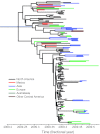Evolution in health and medicine Sackler colloquium: The comparative genomics of viral emergence
- PMID: 19858482
- PMCID: PMC2868293
- DOI: 10.1073/pnas.0906193106
Evolution in health and medicine Sackler colloquium: The comparative genomics of viral emergence
Abstract
RNA viruses are the main agents of emerging and re-emerging diseases. It is therefore important to reveal the evolutionary processes that underpin their ability to jump species boundaries and establish themselves in new hosts. Here, I discuss how comparative genomics can contribute to this endeavor. Arguably the most important evolutionary process in RNA virus evolution, abundant mutation, may even open up avenues for their control through "lethal mutagenesis." Despite this remarkable mutational power, adaptation to diverse host species remains a major adaptive challenge, such that the most common outcome of host jumps are short-term "spillover" infections. A powerful case study of the utility of genomic approaches to studies of viral evolution and emergence is provided by influenza virus and brought into sharp focus by the ongoing epidemic of swine-origin H1N1 influenza A virus (A/H1N1pdm). Research here reveals a marked lack of surveillance of influenza viruses in pigs, coupled with the possibility of cryptic transmission before the first reported human cases, such that the exact genesis of A/H1N1pdm (where, when, how) is uncertain.
Conflict of interest statement
The author declares no conflict of interest.
Figures


References
-
- Taubenberger JK, Reid AH, Frafft AE, Bijwaard KE, Fanning TG. Initial genetic characterization of the 1918 “Spanish” influenza virus. Science. 1997;275:1793–1796. - PubMed
-
- Smith GJ, et al. Origins and evolutionary genomics of the 2009 swine-origin H1N1 influenza A epidemic. Nature. 2009;459:1122–1125. - PubMed
-
- Obenauer JC, et al. Large-scale sequence analysis of avian influenza isolates. Science. 2006;311:1576–1580. - PubMed
Publication types
MeSH terms
LinkOut - more resources
Full Text Sources
Other Literature Sources

